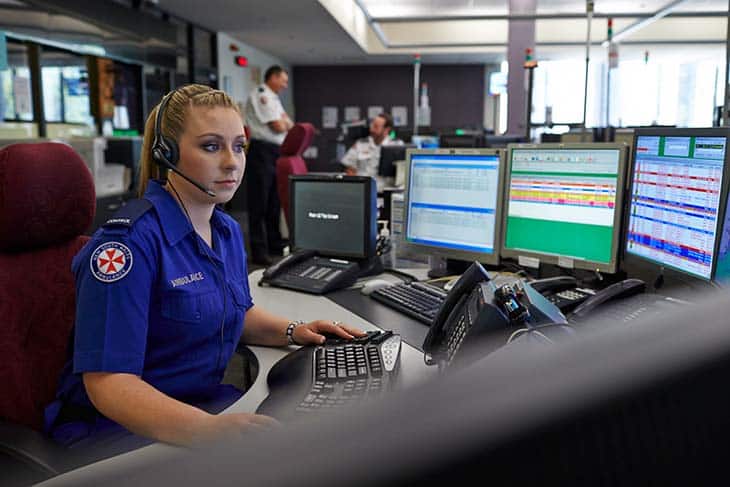2023 EMS Trends from 12 Industry Leaders

Recap - EVOLVE: Traumasoft’s User Conference 2022

The 2022 Traumasoft’s User Conference EVOLVE (held at Gaylord Palms Resort & Convention Center, Central Florida on Nov. 7-9) was a great success! The 3-day event had over 115 in-person attendees and 53 online attendees. They were joined by industry leaders and the Traumasoft team who provided industry insights, trends and brand-new innovations that will impact EMS organizations and the industry as a whole.
The Conference Mission is to EVOLVE
We named the conference ‘EVOLVE’ because we believe EMS software products, solutions and services must be constantly evolving to better service the ever-changing dynamics of the EMS and NEMT industry. The conference is a way for attendees and Traumasoft to connect, learn, and get feedback from EMS organizations, industry experts, and integrations partners so all of us can continue to ‘EVOLVE’ and improve ourselves.
Why Attendees Loved EVOLVE
Introducing New Cutting-Edge Products – Attendees were able to gain specific industry knowledge about new cutting-edge products that can revolutionize the industry. Some of the new products introduced include Ryde Central for streamlined patient transport process, RealTime Routes for AI-powered NEMT routing, and the Employee App for better employee engagement and retention.
Get Expert Insights – Attendees could hear from industry experts that covered topics include Billing and Operations, Cyber Security, employee recruiting and retention using data, cost accounting, EMS legal landmines, and more.
Networking with the Traumasoft Team – Attendees had the opportunity to connect with Traumasoft developers and the executive team to provide feedback, hear about product updates, and request enhancements.
Networking with EMS Organizations – Attendees discussed common problems faced by their fellow EMS organizations and learned about how others solved similar problems. Unique and potential challenges were also uncovered and addressed using Traumasoft’s software platform.
User Training – Attendees attended optional training sessions where they brushed up on or advanced their skills on how to better utilize Traumasoft to increase operational efficiency and profitability. This was especially helpful for those underutilizing Traumasoft’s comprehensive, feature-packed, all-in-one EMS software.
How Attendees Described EVOLVE
Overall Rating of the Event: (4.4 based on 19 responses)
“I’ve been on Traumasoft since 2017 and still left with pages of notes and ideas! I already use all the integrations that the speakers spoke about and can even further integrate after hearing more and speaking with them. Overall, it was very good!” – Debbie R.
“For the first time in 26 years of being in EMS I have a true partner that actually cares about me, not another vendor. My company’s investment in Traumasoft is without a doubt, essential. I can see why your team works so hard. Very impressive.” – Richard S.
“Great information on the billing modules. Created a lot of good questions for the TechLab training.” – Audra O.
“Excellent presentation and a lot of information” – Ellen N.
“Traumasoft has a lot of positive change coming and there is room to provide feedback for change. Lots of helpful information.” – Miranda W.
“Excellent chance to network with other agencies about challenges faced by everyone and how we can use the software platform to help. Also, appreciated the opportunity to speak with developers and others to request changes.” – Eric S.
“Traumasoft is a great software suite. There are so many options and configuration settings it can be overwhelming. Having been with Traumasoft for 10+ years, getting some real answers from experts about how this software works was great. We are under-utilizing this software and have been for some time. I hope to use its full potential through the next year.” – Zachary W.
Topics Covered
Billing Track – An in-depth session on billing best practices and a variety of important billing processes and functions to increase efficiency and overall performance.
New Products Track – Presenting a brief overview of the key products and features that are already available, currently in beta testing, or in development.
Dispatch Track – A comprehensive review of the dispatch process, including MDT, GPS and Advanced Chat. Other topics covered include People & Fleet Operations, the new EPCR, and Business Development Solutions.
Partner Track – Sessions around insights and inspiration with our partner network and how we collaborate to create technology that works better together.
Operations Track – Sessions on how to keep EMS services coordinated and running smoothly, which includes Scheduling as well as People & Fleet Operations and Reporting.
Training Track – Provided one-on-one training on any topic presented, including answering any specific questions about your unique environment.
VIP TechLab – An allotted time that provided an exclusive chance for customers to connect directly with the leadership, technical, and product teams of Traumasoft.
Guest Speakers

J. Todd Sheridan
EMS Leader & Consultant, FItch & Associates

Scott A. Moore
EMS Executive & Attorney, Moore EMS Consulting

Stephen R. Wirth
Founding Partner, Page, Wolfberg & Wirth

Brian S. Werfel
Partner, Werfel and Werfel

Christopher Kelley
Attorney, Page, Wolfberg & Wirth

Omar Masri
CEO, Mamori.io

Kevin E. Frisch
CEO, Banquest Payment Systems
Sponsors
Strategic Partners


Platinum Partners






Gold Partners





Silver Partners




Stay Tuned for EVOLVE 2023
We EVOLVE and get better each year. Subscribe our newsletter and be the first to hear about EVOLVE 2023 and other industry news and insights!
ePCR Software for EMS: A Buyer’s Guide

The recent pandemic only exacerbated those problems. Now the labor shortage is over-stretching EMS capacity nationwide, resulting in unhappy and overworked field workers. Retaining workers is now even more critical than it was pre-pandemic. As a result, financial strain is acute and increasingly, EMS organizations are closing their doors.
A modern ePCR solution can help mitigate these problems. It cannot only benefit front-line crews, but also the EMS organization as a whole.
In this ePCR buyer’s guide, you will learn what to expect from a modern ePCR system. Since there’s a lot of information here, we’ve created a table of contents below so you can navigate to the pertinent sections first. Read more
This Solution can Tackle the EMS Labor Shortage Crisis

It is an understatement to say that EMS’ labor shortage is a dire situation.
NBC News describes the situation as ‘crippling’, with one ambulance operator describing it as “We’re not bleeding any longer – we’re hemorrhaging.”
The situation may lead to a death spiral. EMS needs money to increase wages and to hire but is constrained by reimbursement rates set by private insurance providers, Medicare and Medicaid. The results include one of Wilson County’s EMS stations closing in Oct. 2021.
According to the American Ambulance Association, EMS worker shortage has hit a ‘crisis level’. In their survey conducted in 2020, “the turnover among paramedics and EMTs ranges from 20 to 30 percent annually, resulting in an unsustainable 100 percent turnover every four years.”
Longer 911 wait times and adversely affected EMS services will likely become the new normal. The societal impact could be unimaginable, especially for those in desperate need of health assistance.
In this article, we share how one of Traumasoft’s customers addressed their labor shortage, and how other EMS owners can implement this solution as well.
The Solution: Switch to a Virtual Office to Cut Costs
When the pandemic hit, many companies permitted employees to work from home. Even when restrictions began easing, some companies didn’t require their employees to go back to the office because they found employee output and productivity hadn’t suffered, and in some cases actually improved.
Equally Productivity. Lower Real Estate Costs. Reduced Absenteeism and Turnover.
Companies are using this shift to remote work as an opportunity to cut costs by downsizing or shutting down offices completely. Global Workplace Analytics suggest that companies can save around $11,000 per employee per year when they allow their employees to work remotely 50% of the time – taking into account productivity levels, lower real estate costs, reduced absenteeism and turnover. This explains why many companies, especially tech companies, are switching to long-term remote work for its employees.
The benefits are real – higher productivity, lower turnover, and lower rent. But why hasn’t this trend been applied to EMS?
During the pandemic, EMS staff were classified as “essential workers” and reported to the office as usual. EMS was in high demand, so avoiding disruptions was the best and most logical choice at the time.
But now, EMS is facing a worker shortage crisis, and some organizations are forced to go virtual to retain and attract workers.
How One EMS Company Switched to Virtual Office as a Solution to Labor Shortage
Here’s how one of Traumasoft’s customers enabled a virtual workforce to tackle their labor shortage:
When COVID hit, we were able to allow billers to work remotely, from home, and the transition was easy with Traumasoft. In fact, I’m not sure if we would have been able to do it with our previous software platform. We’re very grateful we made the switch to Traumasoft. Now, with the staffing shortage and factors like Amazon paying folks a starting wage of $27/hr, we were able to move our dispatch/communication center to rural areas where we could find workers. Again, this would not be possible without Traumasoft. In fact, we are working towards a future where dispatchers will be able to work remotely from home, and Traumasoft is a huge piece of this. – Ricky Powell from Allegiance Mobile Health.
Allegiance is the largest privately owned ambulance service based in Texas. Allegiance operates both 911 and Non-Emergency Services in over 60 counties and has 7 remote dispatch centers, all on Traumasoft.
For those organizations in desperate need of workers, you can follow Allegiance’s model:
- Allow office workers, like billers and dispatchers, to work remotely.
- If you can’t find workers, try rural areas. Standard EMS pay in cities are highly competitive pay in rural areas.
- Your whole dispatch center can be moved to rural areas for additional real estate cost-savings. Your city-based dispatchers can work remotely.
Once you go virtual, growing and scaling your business will become easier too. New employees need only a laptop and a good internet connection to do their job. Onboarding new hires will be faster, resulting in shorter time to productivity.
Of course, this applies to office workers and not frontline employees. In the current environment, retaining and hiring EMT’s and paramedics has become a huge challenge.
How Cost Saving from Virtual Office Can Retain Frontline EMS Workers
As quoted above from Ricky Powell at Allegiance, Amazon’s competitive pay is attracting EMS workers, including EMT’s. Here’s how Robert Luckritz, the chair of National Association of Emergency Medical Technicians’ EMS Workforce Committee, describes the situation:
“When you’re an EMS provider putting your life on the line and entering into closed environments with infectious patients and you can make more money to work in an Amazon warehouse, it becomes really difficult to retain people”.
To retain frontline EMS workers, you’ll need to offer more competitive compensation than Amazon. Since raising prices for your services is not an option, a more viable alternative is to reduce back-office and dispatch center costs (via virtual office) and reallocate those savings to frontline EMS providers’ pay and benefits.
This solution may sound compelling, but can every EMS organization implement it?
Not Every EMS can Deploy Virtual Office
Now that you know the benefits of a virtual office, don’t jump the gun and start transitioning without careful thought and planning.
As an EMS owner/operator, first ask yourself whether you can operate efficiently without your staff physically present in the office? The questions below help expose your considerations:
- What is the level of staff-to-staff communication in the office every day? How many of those conversations are essential to getting work done?
- How frequently does someone have to chase down another person just to get things done?
- Are you dependent on face-to-face conversations and/or physical documentation? Can you operate efficiently without paper?
If the bulk of your work is still manual, then moving to a virtual office may not be workable. While theoretically doable, you may be stifled operationally as your staff constantly needs to make phone calls (and accompanying phone tagging) simply to get anything done. Even if you could deploy a virtual office, the inefficiencies could result in ballooning accounts receivables and lower overall utilization rate.
A prerequisite to effectively deploy a virtual office is to implement a robust and integrated EMS management system.
A Robust, Integrated System Enables Virtual Office, Cost Savings, and Profitability
As referenced above, most companies that are switching to long-term remote work are technology companies.
Why? Because they have implemented software systems that eliminate verbal and physical paper trails while streamlining communications and operations.
That’s exactly what Traumasoft does for EMS organizations.
In fact, Ricky Powell from Allegiance opines: In fact, I’m not sure if we would have been able to do it with our previous software platform. We’re very grateful we made the switch to Traumasoft.
Why is that? Here are the 3 major reasons:
First, Traumasoft makes dispatching easy and intuitive. For instance, when ABLE Medical switched to Traumasoft from their in-house software, “It’s a whole lot quieter in the dispatch center, even on a crazy busy day” because the Traumasoft dashboard includes everything a dispatcher needs to do their job effectively. Radios and telephones are essentially eliminated, and they don’t have to coordinate with patients unless there’s a problem.
Second, Traumasoft is a fully integrated EMS management software where data is streamlined across all departments. When First Call Ambulance implemented ZOLL for billing, they had to manually transfer data to their billing software because of integration challenges. They frequently encountered data entry errors or missing patient information, and they had to chase down crew members to rectify those errors. With Traumasoft, ePCR and billing are fully integrated, which shortened their billing cycle, increased billing efficiency, and contributed to overall profitability.
Third, Traumasoft makes reporting simple. Because all data is housed under one integrated system inside Traumasoft, actionable reports can be easily generated with reliable data. At any given time, you can easily track pay rates and hours, see mileage on a truck, generate accounts receivable balances, report on unit hour utilization (UHU) by unit and by office, and do much more. This is evidenced by how NORCAL Ambulance was able grow profitably using data. They closely monitor utilization rates and average pay per call (APC) per division in different geographical regions to ‘get a feel for things’ so they can make immediate adjustments when needed.
If you have a system that includes all of the above, then you are prepared to transition to a virtual office and tackle your employee shortage crisis.
Transitioning to Virtual Office to Overcome the Labor Shortage
The first step of the transition process is to ask office workers to work remotely for 2-3 days a week. You can start by rotating their work from home schedule so at least one employee is physically present in the office during hours of operation.
It’s important to monitor your workflow during implementation. Is productivity the same? Are dispatched units on-time? Does it take billers the same amount of time to submit a claim?
If you answered ‘yes’ to all three questions, you can begin tackling your labor shortage by hiring remote workers.
If you want to go further and save on real estate costs, the next phase is to schedule all office workers to work remotely on designated days of the week so that no one is in the office. Again, you’ll need to monitor your operations and workflows during those days to quickly identify and fix bottlenecks. When issues and disruptions are identified and subsequently mitigated, then you’re ready to go fully remote.
Conclusion
If insurance providers, Medicare, and Medicaid do not adjust EMS rates, the EMS labor shortage crisis could be the new normal. Worse, the situation may death spiral, eating away profits and force more EMS to close up shop.
Thankfully, at least one Traumasoft customer has found an answer to their labor shortage. Maybe it’s something you should consider.
Interested in more details on how Allegiance transitioned to virtual office? Schedule a demo to find out.
How to Unlock EMS Profitability by Using Utilization Rate

As a provider of all-in-one Emergency Medical Services (EMS) management software, Traumasoft understands how tough it is for EMS organizations to increase profitability. With 12+ years of experience working with 200+ EMS organizations, we’ve observed that profitable EMS organizations focus on one key metric: Utilization Rate, which includes Unit Hour Utilization (UHU). Read more
Hidden Reimbursement Proceeds Most EMS Organizations Miss Out On

9 Overlooked Areas in EMS Operations That Could be Hurting Your Margins

Profit margins are thin. Your cash flow is often at the mercy of timely Medicare, Medicaid, and private insurer reimbursements, patients who don’t pay their bills, and even municipal budgets. Even if you are diligent about following the rules, most of you get tripped up by some silly new or obscure regulation.
While most organizations focus on revenues by increasing collections rate, and understandably so, they often overlook many other areas that can help improve their top and bottom lines. Read more
9 Problems Your EMS Billing Software Should’ve Solved Yesterday

The latest data provided by Page, Wolfberg & Wirth, LLC, using Medicare data provided by Center for Medicare & Medicaid Services (CMS), shows that a full 10% of all Medicare claims filed by EMS organizations were denied. That 10% translates to approximately 123 million claims. Of those claims, 3% are appealed. The appeal process takes years to resolve and will face further delay as additional appeals pile in.
The referenced data dates back to 2015, but we think the picture is very similar today. Read more
2021 EMS Predictions from 17 Top Industry Leaders

What is EMS Software? Definition, Benefits & Features
